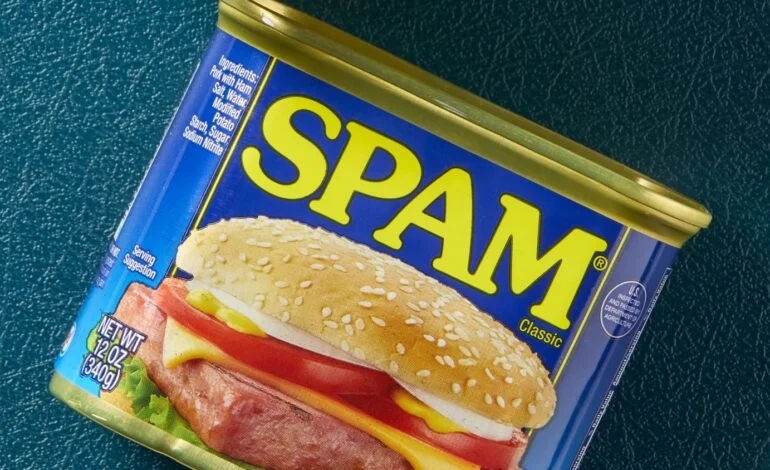Spam has been a beloved staple in many households for over 80 years, earning a place in kitchens worldwide from Hawaii to Korea. But despite its widespread popularity, Spam is often the subject of health debates. Is it a convenient and affordable protein source, or is it a processed meat that could pose risks to your health? In this article, we will explore the health effects of Spam, its nutritional profile, the controversy surrounding processed meats, and the cultural significance of Spam in different regions.
What Is Spam?
Spam is a canned meat product made primarily from pork shoulder and ham, along with added preservatives and flavorings. First introduced by Hormel Foods in 1937, Spam became an iconic convenience food during the World War II era when it was shipped to military troops worldwide. Today, it remains a widely consumed product, especially in countries like Hawaii and Korea, where it has become a cultural mainstay.
Read more information: spam food. Click here!
Ingredients of Spam
The ingredients in Spam typically include:
- Pork (shoulder and ham)
- Salt
- Water
- Potato starch (as a binder)
- Sugar
- Sodium nitrite (a preservative)
These ingredients are combined and cooked under pressure in the can, which helps preserve the meat and give Spam its distinct texture and taste.
Spam: A Source of Protein and Nutrients
Spam provides protein, a vital nutrient for muscle repair, immune function, and overall bodily maintenance. It also offers some essential vitamins and minerals, including:
- Vitamin B12 (important for red blood cell production and neurological health)
- Iron (supports oxygen transport in the blood)
- Magnesium (essential for muscle function and bone health)
However, while Spam can be a convenient source of protein, it’s important to weigh its benefits against the potential health risks.
The Health Risks of Spam: Is Spam Bad for You?
1. Processed Meat and Cancer Risk
Spam, like many other processed meats, is classified as a Group 1 carcinogen by the World Health Organization (WHO). This classification is based on evidence linking processed meats (those that have been salted, cured, or smoked) to an increased risk of certain types of cancer, particularly colorectal cancer. The preservatives used in Spam, especially sodium nitrite, can form nitrosamines when heated, compounds that have been shown to promote cancer in animal studies.
Several large studies have shown that the more processed meat you consume, the higher the risk of developing cancer. According to the WHO, each 50g portion of processed meat consumed daily increases the risk of colorectal cancer by 18%. While consuming Spam occasionally may not pose a significant health risk, regular consumption of processed meats should be approached with caution.
2. High Sodium Content
Spam is notoriously high in sodium. A typical serving (about 2 ounces or 56g) contains around 790 milligrams of sodium, which is about 33% of the recommended daily intake for adults. High sodium intake is linked to several health issues, including:
- High blood pressure (hypertension)
- Heart disease
- Stroke
- Kidney disease
Excess sodium can also lead to fluid retention, causing swelling and bloating. For individuals with certain health conditions, such as high blood pressure or kidney disease, consuming Spam regularly may exacerbate these issues.
3. High Fat Content
Spam is also high in fat, particularly saturated fat, which is known to increase LDL cholesterol (the “bad” cholesterol) levels. A single serving of Spam contains approximately 7 grams of fat, with 3 grams being saturated fat. Consuming too much saturated fat can contribute to the development of heart disease, stroke, and other cardiovascular problems. While Spam can be part of an occasional balanced diet, frequent consumption could negatively impact long-term health.
4. Preservatives and Additives
Spam contains sodium nitrite, a preservative used to prevent bacterial growth and give the meat its pink color. While sodium nitrite helps increase the shelf life of Spam, there is ongoing concern over its long-term consumption. In large amounts, nitrites can be converted into nitrosamines—potentially carcinogenic compounds.
While occasional consumption of Spam is unlikely to pose a major health risk, excessive intake of nitrates and nitrites from processed meats should be avoided for those who want to maintain optimal health.
Spam’s Cultural Significance: Hawaii and Korea
Spam is more than just a food item—it’s part of cultural traditions in certain regions. Let’s explore its significance in Hawaii and Korea.
Spam in Hawaii
In Hawaii, Spam has been a staple for decades, with an estimated 5 million cans of Spam consumed annually by residents. Spam is a key ingredient in dishes like Spam musubi (a sushi-like snack with Spam, rice, and seaweed), Spam fried rice, and Spam sandwiches. The popularity of Spam in Hawaii can be traced back to World War II when the U.S. military shipped large quantities of canned Spam to the islands. It became a reliable source of protein for residents, and over time, it became deeply integrated into local cuisine.
Spam in Korea
In South Korea, Spam holds a special place in the country’s culinary traditions, often appearing during major holidays or special occasions. It is often used in dishes like budae jjigae (army stew), which combines Spam, sausage, and other ingredients in a spicy broth. The love for Spam in Korea can also be attributed to its long shelf life, making it a convenient and affordable option during the Korean War and beyond.
Spam’s Nutritional Breakdown
Here’s a quick look at the nutritional profile of Spam per 2-ounce (56g) serving:
- Calories: 180
- Protein: 7g
- Total Fat: 16g
- Saturated Fat: 3g
- Sodium: 790mg
- Cholesterol: 30mg
- Carbohydrates: 1g
- Sugars: 1g
- Iron: 4% of daily value
- Magnesium: 2% of daily value
Spam can be a high-calorie food choice, and while it provides protein, it also delivers a significant amount of sodium and fat. Moderation is key.
Who Eats Spam?
Spam has a loyal fan base across the globe, with particular popularity in Hawaii and Korea. In the U.S., Spam is commonly consumed by people seeking an affordable, long-lasting source of protein. It also has a dedicated following among campers, preppers, and individuals who appreciate its shelf stability. While Spam’s reputation may be divisive in some parts of the world, its cultural and historical significance cannot be overlooked.
Should You Eat Spam?
Spam offers convenience, affordability, and a decent amount of protein, but it comes with several health risks that shouldn’t be ignored. Its high sodium, fat content, and processing methods make it less than ideal for regular consumption, especially for individuals with certain health concerns like hypertension or heart disease. Ravoke.com, we emphasize the importance of making informed dietary choices to maintain long-term health and well-being.
While enjoying Spam occasionally won’t have a major impact on your health, it’s important to balance it with a diet rich in whole, unprocessed foods. If you do enjoy Spam, consider eating it in moderation and pairing it with nutrient-dense foods like vegetables, whole grains, and healthy fats to mitigate some of the negative effects.
Also Read about: 15 Best Standing Desk Exercises : With & Without Equipment



